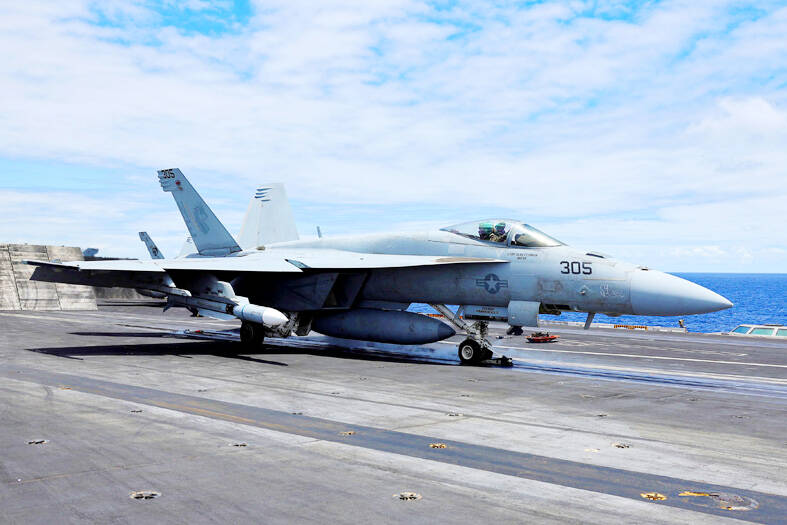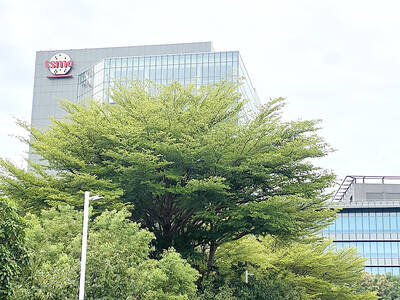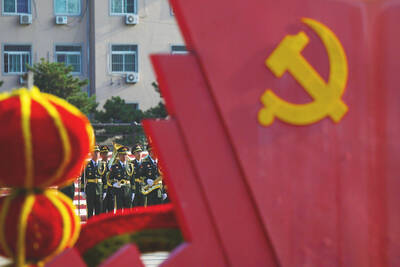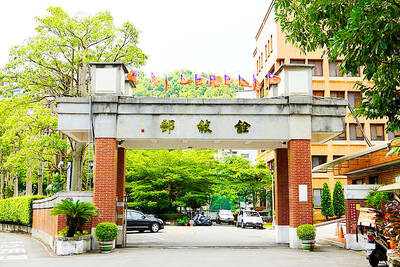The US Navy’s deployment of new extremely long-range air-to-air missiles in the Indo-Pacific region could erase China’s advantage in aerial reach, experts say, part of an intensifying focus on projecting power amid high tensions in the region.
The AIM-174B, developed from the readily available Raytheon SM-6 air defense missile, is the longest-range such missile the US has ever fielded and was officially acknowledged last month.
It has three key advantages: It can fly several times farther than the next-best US option, the AIM-120 AMRAAM (advanced medium-range air-to-air missile); it does not require new production lines; and it is compatible with the aircraft of at least one ally — Australia.

Photo: Reuters
Crucially, a weapon such as the AIM-174B, which can attack aerial targets as far away as 400km, outranges China’s PL-15 missile, allowing US jets to keep threats farther from aircraft carriers and safely strike “high-value” Chinese targets, such as command-and-control planes.
“The United States can ensure the safety of their important assets, such as carrier groups, and launch long-range strikes on PLA [Chinese People’s Liberation Army] targets,” said Chieh Chung (揭仲), a researcher at the Taipei-based think tank Association of Strategic Foresight.
The West has not easily been able to do that until now.
The AIM-120, advanced medium-range missile for US aircraft, has a maximum range of about 150km, which requires the launching aircraft to fly deeper into contested territory, exposing aircraft carriers to greater danger of anti-ship attacks.
Any type of South China Sea conflict, within the so-called First Island Chain, which runs roughly from Indonesia northeast to the Japanese mainland, means the US Navy would operate within a few hundred kilometers of its Chinese adversary.
Supporting Taiwan in an invasion would pull the US Navy in even closer.
The AIM-174B changes that equation, keeping PLA carrier-hunting aircraft out of firing range and even endangering their planes attacking Taiwan, Cheih said.
That increased the likelihood the US would get involved in a major conflict in the region, he added.
“The big thing is that it lets the United States push in a little bit further” into the South China Sea during a conflict, said a senior US defense technical analyst, who declined to be identified because the matter is sensitive.
“And it’s going to potentially change Chinese behavior because it’s going to hold large, slow, unmaneuverable aircraft at greater risk,” they said.
For decades, the US’ advantage in stealth fighters, first with the F-117 and then with the F-22 and F-35, meant that missiles such as the AIM-120 were all that was needed.
The US military also leaned into developing the AMRAAM as a cheaper alternative to a new missile, drastically improving its performance over decades, said Justin Bronk, an airpower and technology expert at London’s Royal United Services Institute.
The SM-6 is estimated to cost about US$4 million each, the Missile Defense Advocacy Alliance said, while an AMRAAM costs about US$1 million.
European nations, which lacked access to stealth technology until past few years, developed the ramjet-powered Meteor missile, with a range of 200km, produced by MBDA.
MBDA did not respond to a request for comment.
The advent of Chinese stealth aircraft such as the J-20, and more important, the PL-15 missile it can carry internally — with a range of 250km or more — eroded the US’ edge, Stimson Center senior fellow Kelly Grieco said.
Now a stealth Chinese aircraft could theoretically spot non-stealth US aircraft and shoot them down well outside the range where they could even fight back, she said.
Even US stealth aircraft might be forced to fly dangerously close to fire their missiles.
“If a Chinese fighter can outrange an American fighter, it means they can get the first shot,” she said. “It’s hard to outrun something that’s traveling at Mach 4.”
The AIM-174B was developed to quickly address that need.
The secretive Lockheed Martin AIM-260, a separate US Air Force program to develop an extremely long-range air-to-air missile small enough for stealth aircraft to carry internally, has been in development for at least seven years.
Lockheed Martin declined to comment on the project.
China is developing missiles with longer range than the PL-15, Bronk said, but the radar of launching aircraft might be unable to spot targets at such distances.
“If you go too big and too heavy with the missiles, you end up trading off fuel” for the aircraft, he added.
Using Raytheon’s SM-6, originally designed for a ship-launched air defense role, means production lines are already available. Funding has already been earmarked for more than 100 SM-6 missiles a year.
Raytheon declined to comment on how many AIM-174Bs would be produced or if existing SM-6s would be converted.
So far it has only been shown on US Navy F/A-18E/F Super Hornet aircraft, which are operated by the US and Australian militaries.
The US sees Australia as a crucial ally and location for projecting power into the South China Sea, and is investing hundreds of millions of dollars in military infrastructure there.
The Australian Department of Defence said it “works closely with the US to understand capability options available for Australian consideration”.
The US Department of Defense referred questions about the AIM-174B to the US Navy.
The US Navy said the missile was “operationally deployed,” but declined to comment on whether it would be supplied to allies, whether it would be integrated onto other aircraft, and how many AIM-174Bs it wanted each year.
The versatility of the SM-6, which has also been used to hit ships, land targets and missiles, opens up possibilities beyond the AIM-174B, said Peter Layton, a defense and aviation expert at the Griffith Asia Institute.
For instance, if fitted with an anti-radar seeker, it could attack and disrupt surface-to-air missile batteries from extremely long range.
For now, adding the AIM-174B to the US Navy’s arsenal, even if not yet in large numbers, changes the calculus of a regional conflict, the senior technical analyst said.
“If this is enough to push [China’s high-value] aircraft way back, then you don’t need many,” the analyst added. “Because the threat has caused the adversary to change their behavior... It makes a South China Sea scenario easier.”

Taiwan Semiconductor Manufacturing Co (TSMC, 台積電) is expected to start construction of its 1.4-nanometer chip manufacturing facilities at the Central Taiwan Science Park (CTSP, 中部科學園區) as early as October, the Chinese-language Liberty Times (the Taipei Times’ sister newspaper) reported yesterday, citing the park administration. TSMC acquired land for the second phase of the park’s expansion in Taichung in June. Large cement, construction and facility engineering companies in central Taiwan have reportedly been receiving bids for TSMC-related projects, the report said. Supply-chain firms estimated that the business opportunities for engineering, equipment and materials supply, and back-end packaging and testing could reach as high as

CHAMPIONS: President Lai congratulated the players’ outstanding performance, cheering them for marking a new milestone in the nation’s baseball history Taiwan on Sunday won their first Little League Baseball World Series (LLBWS) title in 29 years, as Taipei’s Dong Yuan Elementary School defeated a team from Las Vegas 7-0 in the championship game in South Williamsport, Pennsylvania. It was Taiwan’s first championship in the annual tournament since 1996, ending a nearly three-decade drought. “It has been a very long time ... and we finally made it,” Taiwan manager Lai Min-nan (賴敏男) said after the game. Lai said he last managed a Dong Yuan team in at the South Williamsport in 2015, when they were eliminated after four games. “There is

Democratic nations should refrain from attending China’s upcoming large-scale military parade, which Beijing could use to sow discord among democracies, Mainland Affairs Council Deputy Minister Shen You-chung (沈有忠) said. China is scheduled to stage the parade on Wednesday next week to mark the 80th anniversary of Japan’s surrender in World War II. The event is expected to mobilize tens of thousands of participants and prominently showcase China’s military hardware. Speaking at a symposium in Taichung on Thursday, Shen said that Chinese Minister of Foreign Affairs Wang Yi (王毅) recently met with Indian Prime Minister Narendra Modi during a visit to New Delhi.

FINANCES: The KMT plan to halt pension cuts could bankrupt the pension fund years earlier, undermining intergenerational fairness, a Ministry of Civil Service report said The Chinese Nationalist Party (KMT) caucus’ proposal to amend the law to halt pension cuts for civil servants, teachers and military personnel could accelerate the depletion of the Public Service Pension Fund by four to five years, a Ministry of Civil Service report said. Legislative Speaker Han Kuo-yu (韓國瑜) on Aug. 14 said that the Act Governing Civil Servants’ Retirement, Discharge and Pensions (公務人員退休資遣撫卹法) should be amended, adding that changes could begin as soon as after Saturday’s recall and referendum. In a written report to the Legislative Yuan, the ministry said that the fund already faces a severe imbalance between revenue